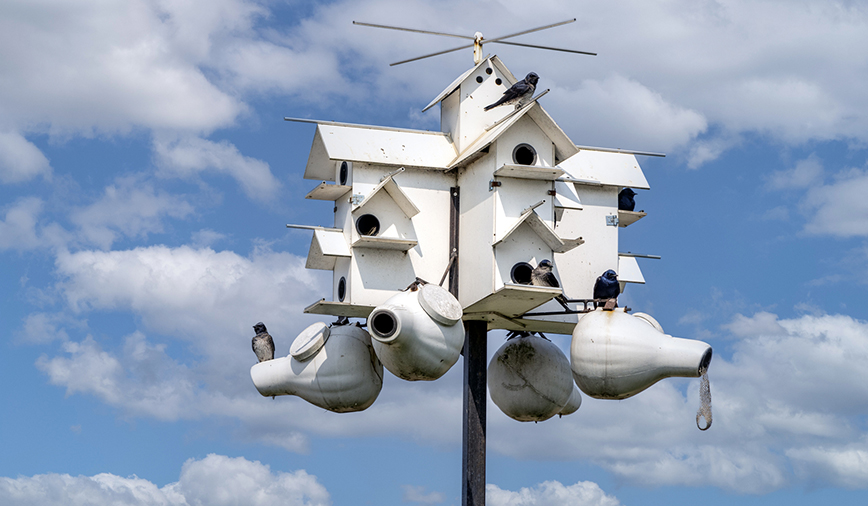If you’ve ever visited Hickory Knolls during the months of May, June or July, you’ve probably noticed a certain bubbliness in the air, a constant, cheerful chatter that surrounds the nature center and garden plots.
Long-time residents will recognize the sound as a distinguishing feature of this area, one that dates back to the days when James O. Breen Park was known as Campton Hills Park, and the Hickory Knolls Discovery Center was a distant dream. Birders will recognize the sound as the calls of the purple martin, Progne subis.
Park district employees, meanwhile, recognize that none of those happy sounds would be heard here if it weren’t for the efforts of our dedicated volunteer Mike Swanson. Mike established the martin colony years ago, and devotes countless hours each year to the care and maintenance of the birds’ housing—white compartmental housing sometimes referred to as “apartments” (and yes, purple martin caretakers are often called landlords) as well as white, weatherproof plastic gourds.
Besides the happy-sounding calls from Mike’s “tenants,” we employees are also lucky enough to receive periodic updates on the martin colony, plus the bluebird and tree swallow houses Mike also maintains and monitors. Some of these reports contain detailed facts and figures on nests, eggs, nestlings, successful fledges, etc., while others are narratives of Mike’s observations.
The one that arrived the other day was so descriptive, and delightful, I thought you’d enjoy reading it too:
“In mid August when I arrived at the park to monitor the nest boxes for what I expected to be the last time this year, I was surprised to still find some martins on and near two of the martin houses. The martins are usually gone by the end of July or early August. I found very large chicks in two of the nests.
“As I lowered the house near Campton Hills Road, a chick left one of the Super Gourds attached to the house. Since martins are the only birds in the park that return to roost in their nests after fledging, I don’t know if the bird had just fledged or it left because it was disturbed while it was roosting. Its behavior made me suspect it had just fledged.
“The chick flew upward over the soccer field. Then it headed towards the tree line adjacent to Campton Hills Road; and landed near the top of the tallest tree there.
“I finished lowering the house. One more large chick was found in the gourd. No other birds were found in the house or the other gourd, so I gently returned the house to its raised position without the remaining chick leaving its nest.
“The fledgling began what I considered to be a distress call. Within a few seconds the chick’s father flew towards the tree and circled over the field as it called to the chick. The chick kept calling; but didn’t join its father, so the father joined the chick in the tree. They chatted for about a minute.
“Then the father left the tree and circled above the field until the chick joined him. Then the father escorted the chick to a tall, dead tree near the entrance to the park. After the father perched on one of the bare branches, the chick joined him on another one. They chatted for about a minute.
“Then the father flew alone toward the gourd where his mate was perched on the gourd’s porch. She had returned while the father was tending to the fledgling. She called to the chick inside the gourd. Then she went inside cautiously to check it before returning the porch.
“She and her mate chatted for a few seconds. Then he returned to the fledgling in the tree, and two other martins joined them. I think they were probably also his chicks that had fledged earlier. They all continued to chat for a minute or two before he returned to his mate.
“The fledglings remained in the tree where one of them exercised its wings while it was perched, and another took a short flight before returning to the tree. The dead tree provided the fledglings with bare branches to perch without leaves obstructing them.
“The fledglings also demonstrated the tree provided a good site to exercise their wings and take short flights to improve their flying and perching skills. The bare branches provided a clear view of their parents as well as potential threats approaching the fledglings. In addition, while their parents were hunting for all of their chicks and caring for the remaining one in the gourd, the chicks in the tree could be easily monitored by their parents.
Mike ended his story with the thought, “This experience reminded me that even dead trees can have an important role in the lives of the birds.”
I’m a big fan of dead trees too, but I think in this case the credit for the success of these birds should go to Mike. I hope the Good Natured readers will join me in in thanking him for his efforts. Hats off to you Mike!
Pam Erickson Otto is the manager of nature programs and interpretive services at the Hickory Knolls Discovery Center, a facility of the St. Charles Park District. She can be reached at 630-513-4346 or potto@stcparks.org.
September 4, 2015
Purple Martins
Purple martins in the eastern United States are 100% reliant on humans to provide nesting sites. The units at James O. Breen Community Park are meticulously maintained on a volunteer basis by expert ‘landlord’ Mike Swanson.

